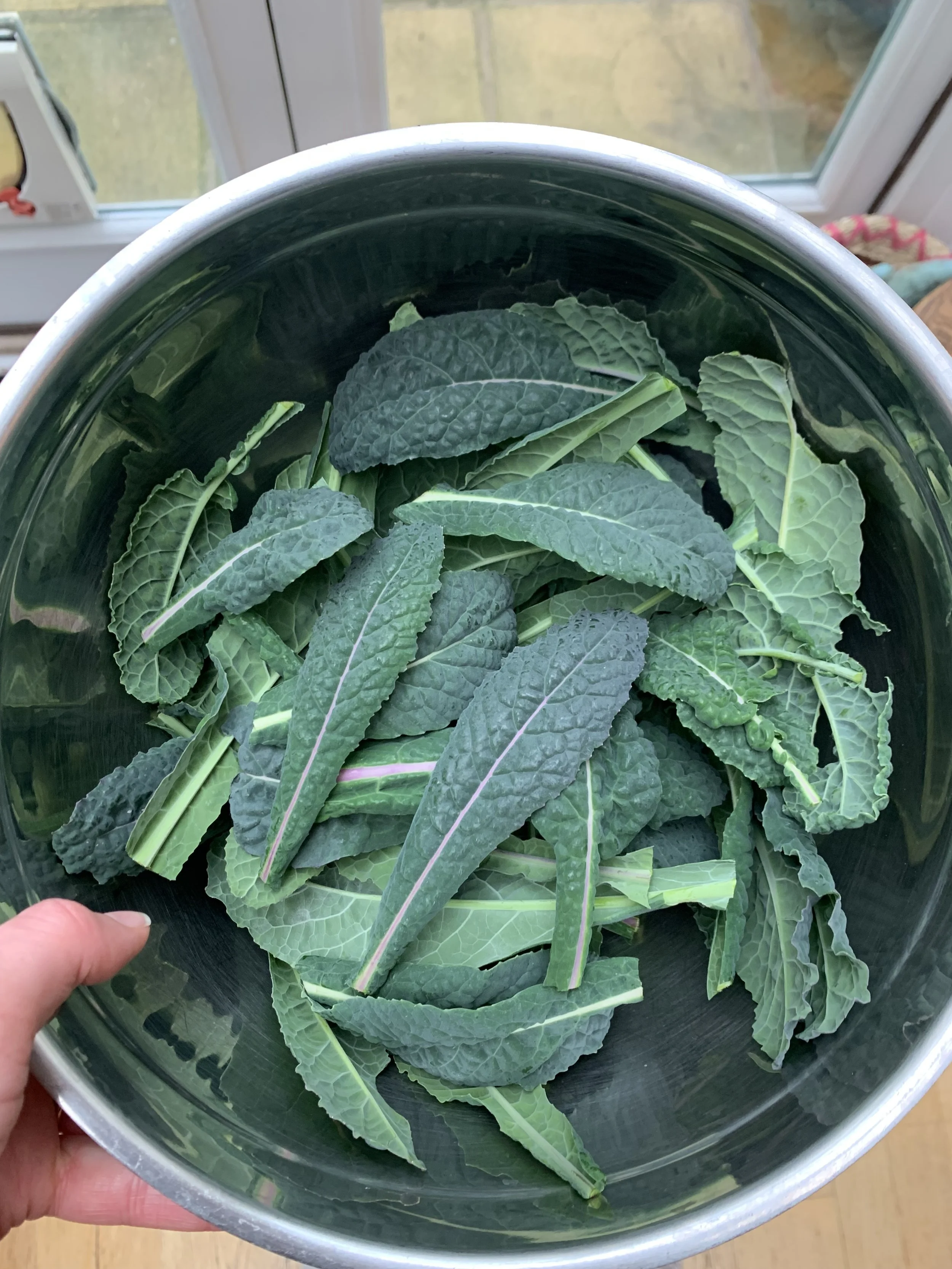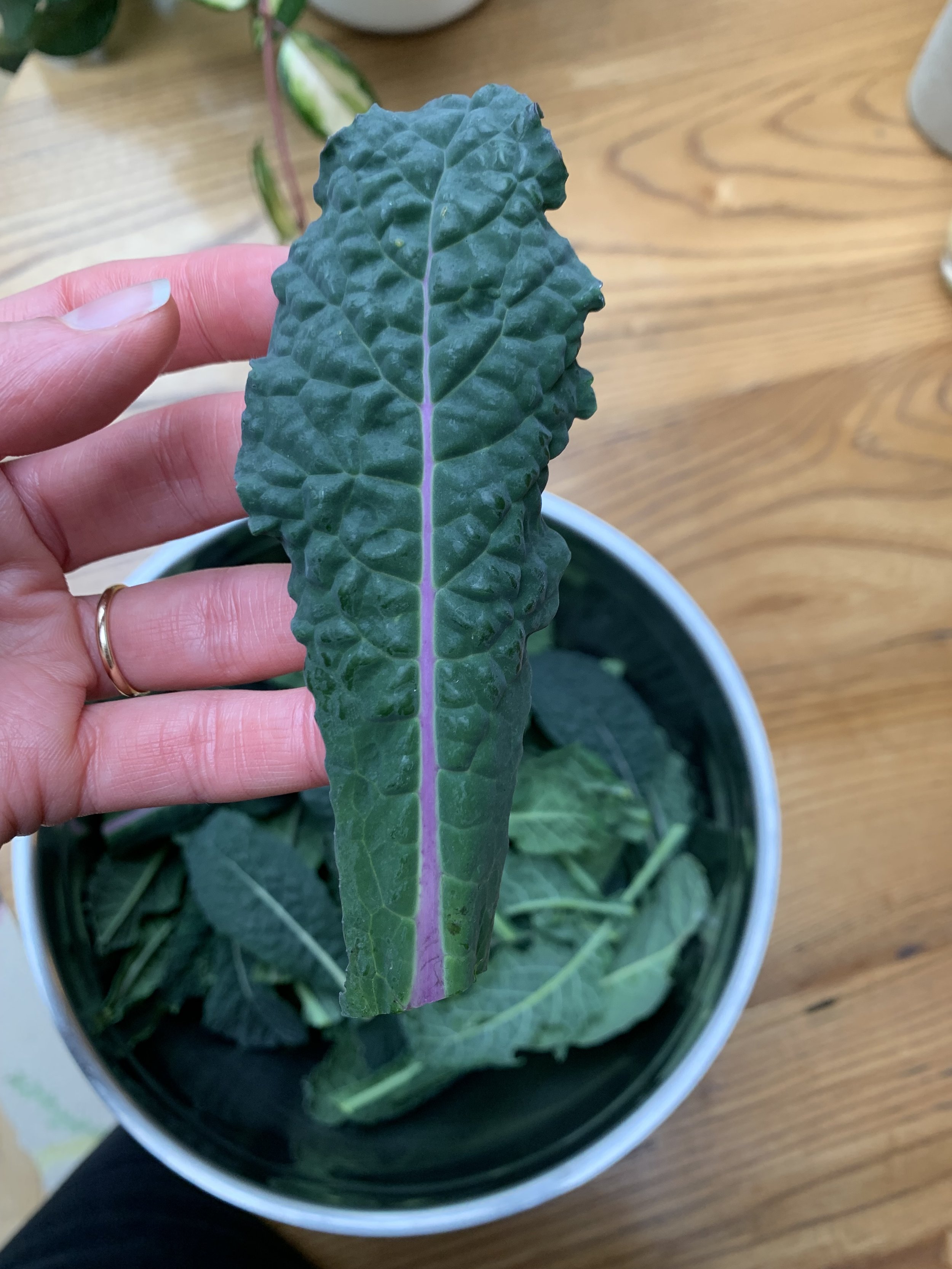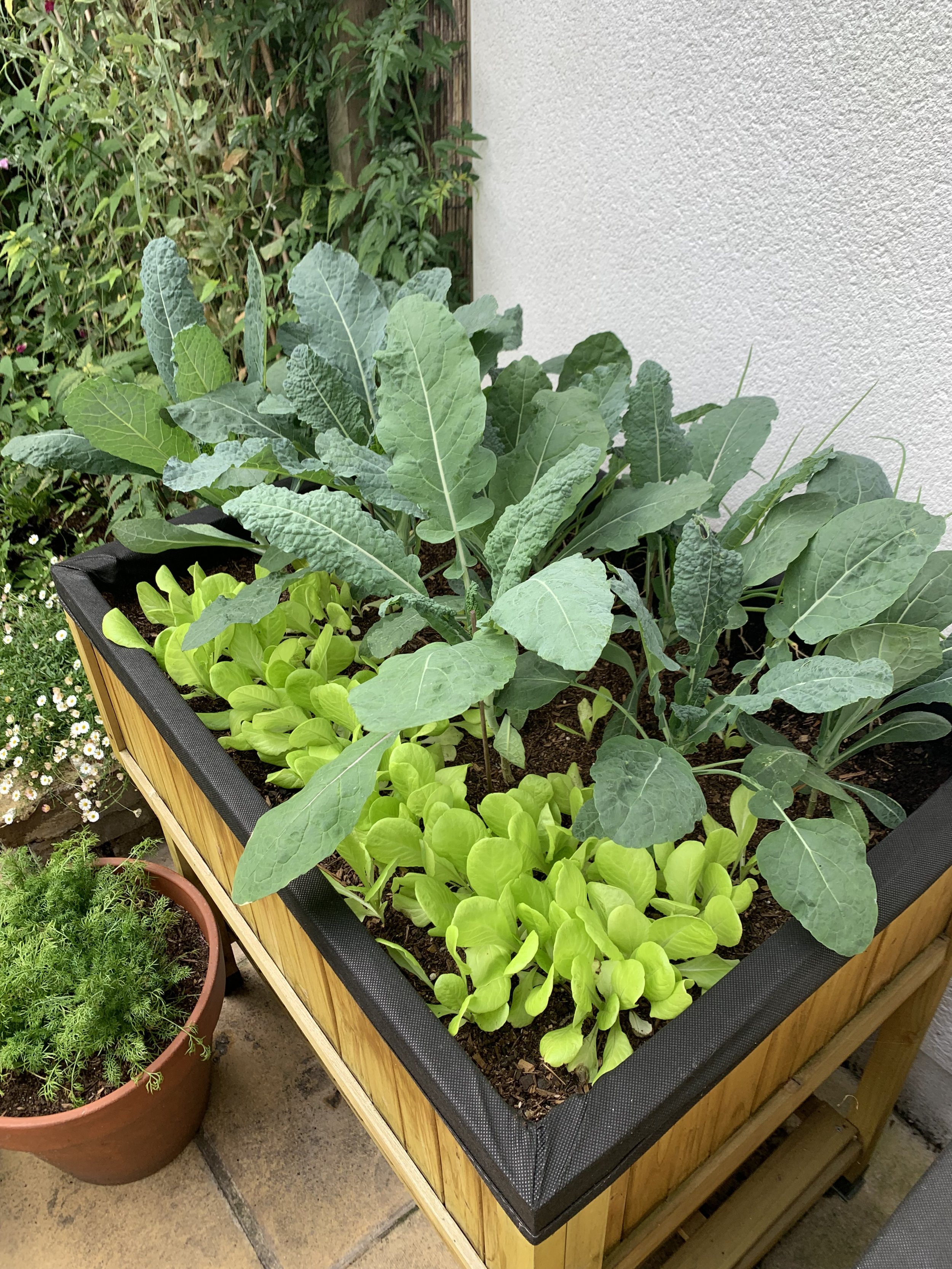When to Harvest Kale
This article has links to products that I may make commission from.
Kale, with its rich green color and incredible health benefits, has become a mainstay in gardens.
If you've taken the leap to plant kale, the fun has just begun.
Whether you're nurturing several kale plants in a sprawling garden or just a couple in your urban balcony space, understanding the intricacies of growing and harvesting is essential.
When the time is right to harvest kale leaves, there's a method to ensure you get the most out of each plant.
Here we will delve deep into the world of growing kale, offering insights on when and how to pluck those leaves first and continue to enjoy a bountiful yield throughout the season.
To learn more about growing kale, check out my guide:
My recent harvest of baby kale.
When to Harvest Kale by Variety
When it comes to harvesting kale, timing plays a pivotal role.
Picking kale at the right time ensures you get the best flavor and nutritional value from each leaf.
Different varieties of kale might have slightly different maturation rates.
Curly Kale:
Recognizable by its ruffled leaves, curly kale is ready to be harvested when the leaves are about the size of your hand.
Dinosaur (Lacinato) Kale:
This variety has elongated, bumpy leaves and can be harvested once they are around 10-12 inches long.
Red Russian Kale:
This variety is known for its red-tinted leaves and is ready for harvest when leaves are 8-10 inches long.
Stages of Growth
Baby Kale:
This early stage of kale can be harvested approximately 25-30 days after planting.
With a delicate texture and a milder flavor compared to its mature counterpart, baby kale is a favorite in salads or as a garnish.
Mature Leaves:
Generally, these are ready for harvesting between 70 to 95 days after planting, depending on the variety and growing conditions.
These leaves are heartier and have a robust flavor, suitable for cooking or for making kale chips.
Additional Harvest Tips
Reading the Leaves:
Look for leaves that are firm and deep in color, a sign they are packed with nutrients.
Avoid leaves that appear yellow or have brown spots, as these can indicate age or disease.
Continuous Harvest:
By employing a continuous harvest method, where you pick a few leaves from each plant rather than harvesting a whole plant, you can extend the productive life of your kale garden.
Start by removing the outermost leaves and work your way inward as the season progresses.
Seasonal Considerations:
While kale is cold-hardy and can tolerate light frosts, its flavor profile can change with the seasons.
After a frost, kale tends to become sweeter, making late fall harvests particularly flavorful.
However, in extremely hot conditions, kale might become more bitter; hence, adjusting your harvesting time can lead to better-tasting leaves.
Signs of Over-maturity:
If leaves start to look overly tough or if the plant begins to bolt (produce flowers), it's a signal that the kale is past its prime for harvesting.
While these leaves can still be eaten, they might have a tougher texture and a more bitter flavor.
My 3 favorite types of kale to grow:
For more tips on when to harvest from your vegetable patch, check out my guides:
When to Pick Carrots: The Comprehensive Guide
The Art of Harvesting Tomatoes: When and How to Pick the Perfect Fruit
Baby kale with a beautiful purple midrib.
How to Harvest Kale for Continuous Growth
Kale is a generous vegetable. With the right harvesting techniques, one plant can provide fresh leaves throughout its growing season.
Here's how to ensure you're picking your kale in a way that promotes its continuous growth.
Start from the Outside:
The oldest leaves are typically found on the outside of the kale plant.
By removing these first, you not only get to eat the mature leaves at their peak, but you also encourage the plant to focus its energy on growing new leaves at its center.
The Proper Cut:
When removing a leaf, cut it cleanly using a sharp pair of gardening scissors or shears.
Make your cut close to the main stem, but avoid damaging it. Clean cuts promote better plant health and reduce the risk of diseases.
Stimulating Growth:
As you regularly harvest the mature leaves from the bottom up, the plant responds by producing more foliage from the top, ensuring a steady supply.
If you’ve ever pondered over the question, “how to harvest kale so it keeps growing?” – this bottom-up method is your answer.
Avoid Over-harvesting:
While it's tempting to take many leaves at once, especially if you're planning a big meal, try not to take more than one-third of the plant at any one time.
This ensures that the kale has enough leaves left for photosynthesis, essential for its growth and health.
Bolting is a Signal:
If your kale starts to bolt, or send up a flower stalk, it's a sign that the plant is getting ready to set seed and complete its life cycle.
While you can still harvest and eat the leaves after a plant bolts, they may be tougher and more bitter.
To encourage more leaf production, you can cut off the flower stalk, though this is often a temporary measure.
Consider Succession Planting:
For a steady supply of fresh kale throughout the season, consider planting new seeds or transplants every 2-4 weeks.
This method ensures that as one batch of plants begins to wane, the next batch is coming into its prime.
Learn more with my guide: What is Succession Planting? Grow More in Less Space.
Post-harvest Care:
After harvesting, give the plants a boost. A light watering and occasional feeding with a balanced, organic fertilizer can ensure that the kale plants remain strong and continue to produce fresh, new leaves.
By understanding and applying these techniques, even novice gardeners can enjoy a prolonged harvest period, maximizing their yield from each kale plant.
For more harvest tips, check out my guides:
Rows of kale ready for harvest at the Hampton Court Flower Show.
Understanding the Growth of Kale
Kale, often heralded as a superfood, belongs to the Brassica family, which also includes vegetables like cabbage, broccoli, and Brussels sprouts.
Its growth patterns and attributes make it both a nutritional powerhouse and a favorite among gardeners.
Origins and Varieties:
Kale is believed to have been cultivated as early as 2000 B.C. in parts of Asia and the Mediterranean.
Today, there are various kale varieties available, ranging from curly kale to dinosaur or lacinato kale, each with its distinct flavor and texture.
Kale Plants and Their Resilience:
Kale plants are notably hardy. They can withstand temperatures as low as 20°F (-6°C) and often become sweeter after a light frost.
This resilience means they can be grown in various climates and are especially suitable for cooler regions where many other vegetables might struggle.
Growing Season for Kale:
Planting times can vary depending on your region and the variety of kale you're growing.
Generally, for a summer harvest, seeds or transplants can be started in the spring.
For a fall harvest, mid-summer planting is ideal. As a cold-tolerant crop, kale can even be harvested well into the winter months in some zones.
Soil and Nutritional Needs:
For optimum growth, kale prefers well-draining soil enriched with organic matter.
A soil pH of 6.0 to 7.5 is ideal. Regular watering and occasional feeding with a balanced fertilizer can ensure a bountiful harvest.
Here is the organic compost I recommend for growing kale:
Baby Kale vs. Mature Leaves:
Baby kale leaves, harvested while still young, are tender with a milder flavor, making them great for salads or lightly sautéing.
On the other hand, mature kale leaves have had more time to develop their robust and slightly bitter flavor, making them more suited for hearty dishes like stews or as the primary ingredient for kale chips.
Kale Garden Design and Spacing:
While kale can be a productive plant even when spaced closely, giving each plant enough room can maximize its growth potential.
For smaller varieties, a spacing of 12 inches between plants is adequate.
For larger types, 18-24 inches is preferable. When integrated into a garden design, kale can also act as a beautiful ornamental piece due to its textured leaves and sometimes vibrant colors.
For more inspiration, check out my guide:
My urban garden raised bed with kale ready to harvest.
Storing Your Kale Harvest
After putting in the effort to grow and harvest your kale, the next critical step is ensuring it stays fresh until you're ready to use it.
The right storage methods can prolong the life of your kale and retain its crispness and flavor.
Preparation Before Storage:
Cleaning:
It's a good idea to clean your kale before storing, but be careful not to leave it wet as moisture can accelerate spoilage.
Gently rinse the leaves in cold water to remove any dirt or insects.
Drying:
After washing, pat the leaves dry with a paper towel or use a salad spinner to remove excess moisture.
Refrigerating Kale:
Plastic Bag Method:
Place the dried kale leaves in a plastic bag, ideally with a paper towel inside to absorb any remaining moisture.
Squeeze out as much air as possible and seal the bag. Store it in the vegetable crisper drawer of your refrigerator.
Longevity:
When stored this way, kale can remain fresh for up to a week, though it's best consumed within 3-4 days for optimum flavor and nutrition.
Freezing for Longer Storage:
If you've got more kale than you can use within a week, freezing is an excellent option.
Blanching:
Before freezing, blanch the kale leaves.
This process involves briefly boiling them and then immediately cooling them in an ice bath.
It helps in retaining the color, flavor, and nutritional value.
Storing:
After blanching and draining, spread the kale leaves on a baking sheet to freeze individually.
Once frozen, transfer them to freezer bags, removing as much air as possible before sealing.
Duration:
Properly stored frozen kale can last up to 8-12 months.
Making and Storing Kale Chips:
Preparation:
To make kale chips, toss the cleaned and dried kale leaves in a little olive oil and seasoning of your choice.
Spread them out on a baking sheet and bake until crispy.
Storage:
Once cooled, store your kale chips in an airtight container.
They can remain fresh and crispy for up to a week, though they are often consumed long before that!
Storing in Alternative Forms:
Kale can also be juiced, turned into pesto, or dried and powdered.
Each form has its own storage requirements. For instance, kale powder, when stored in a cool, dark place in an airtight container, can last for several months.
Understanding these storage techniques ensures that the efforts invested in the garden translate to delicious and nutritious meals on the table.
Proper storage not only extends the life of your kale but also helps in reducing food waste.
For more growing tips, check out my guide:
Beautiful rows of kale ready to harvest at Chelsea Flower Show.
FAQs
Kale, a versatile and hearty green, deserves a special spot in every garden.
With the right gardening tips and knowledge about when to harvest kale, you can enjoy fresh kale throughout the year.
How long do kale plants last?
Kale plants are biennials, meaning they complete their lifecycle in two years.
However, in many climates, they're grown as annuals. If left to grow into their second year, they will bolt, or flower, and then set seed.
When is the best time to harvest curly kale?
Curly kale can be harvested as soon as the leaves are large enough to eat, typically when they're the size of your hand.
Remember, after a frost, the leaves often become sweeter!
How do you prune kale?
Pruning kale is about removing old or damaged leaves and encouraging new growth.
Always start with the oldest, outermost leaves and use clean, sharp scissors or pruning shears to make cuts close to the main stem.
How is harvesting kale different from harvesting spinach?
While both are leafy greens, they have different growth patterns.
Spinach is typically harvested by cutting the entire plant off at the base, whereas kale can be harvested leaf-by-leaf from the outside, allowing the plant to continue growing.
Does kale regrow after cutting?
Yes, if you harvest kale by removing individual leaves and avoid cutting the growing tip (the center part of the plant), it will continue to produce new leaves.
When is the ideal time to harvest purple kale?
Purple kale, similar to other kale varieties, can be harvested when the leaves are about the size of your hand. It also becomes sweeter after exposure to frost.
How long does it take for kale microgreens to be ready for harvest?
Kale microgreens can typically be harvested in 7-14 days after sowing, depending on growing conditions and desired leaf size.
What is the growing season for kale?
Kale prefers cooler temperatures and can be grown in both spring and fall. In milder climates, it can even be grown throughout the winter.
When is kale ready to pick?
Kale can be picked as baby leaves after about 25-30 days or as mature leaves between 70-95 days, depending on the variety and growing conditions.
How long does it take kale to grow from seed to harvest?
Depending on the variety and conditions, kale can take anywhere from 25 days (for baby leaves) to 70-95 days (for mature leaves) from seed to harvest.






































